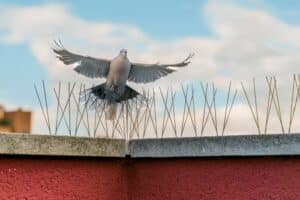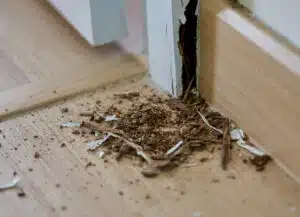If you suspect bed bugs in your home, you’re not alone. The thought of tiny pests invading your space can be unsettling, and knowing what to do next is crucial. At A-1 Exterminators, we’ve spent over 55 years helping Utah homeowners detect and eliminate bed bugs. The first step to reclaiming your home is understanding what you’re dealing with. Follow these five steps to check for bed bugs so you can act fast.
Step 1: Carefully Remove and Isolate Bedding
Bed bugs can spread quickly, so handling your bedding carefully is critical. Since heat is one of the most effective methods for killing bed bugs and their eggs, follow these steps carefully:
- Strip all bedding, including sheets, pillowcases, and mattress covers.
- Handle items gently to avoid disturbing hidden bed bugs.
- Immediately seal bedding in a plastic bag to prevent potential spread.
- Wash bedding in hot water and dry on the highest heat setting for at least 30 minutes.
- Inspect pillows and blankets for signs of bed bug activity before returning them to the bed.
Step 2: Inspect the Mattress
Bed bugs prefer to hide in tight, dark spaces near their host, and mattresses provide an ideal environment. Carefully examine:
- Seams and edges: Look for small, dark brown or black spots similar in size to the tip of a ballpoint pen.
- Corners and tags: These areas provide easy hiding spots.
- Live bed bugs: Adult bed bugs are about the size of an apple seed, reddish-brown, and oval-shaped. Nymphs are smaller, lighter in color, and can appear translucent with a dark spot.
- Shed skins and eggs: As bed bugs grow, they shed their exoskeletons, leaving behind casings—another key sign of an infestation. Their eggs are tiny, about the size of a grain of salt, and white or translucent.
Use a flashlight and a thin card (such as a credit card) to scrape along the folds. If you haven’t found any evidence of bed bugs, proceed to the next step. If you find evidence of bed bugs, it’s best to stop the inspection immediately and call A-1 Exterminators at (801) 968-3370 to prevent further spread.
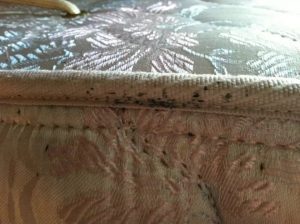
The next picture is also typical of spotting you may find on the top of the folds:


Step 3: Examine the Box Spring
Box springs are one of the most common hiding places for bed bugs. Because of their hollow structure, bed bugs can burrow deep inside. To inspect properly:
- If possible, remove the dust cover to inspect the interior framework, as bed bugs often hide inside.
- Lift the mattress and stand it against a wall.
- Check the underside of the mattress for signs of bed bug activity.
- Stand the box spring upright and examine the bottom dust cover, mainly the corners and edges.
- Look near staples, tacks, and seams—these areas provide ideal hiding spots.
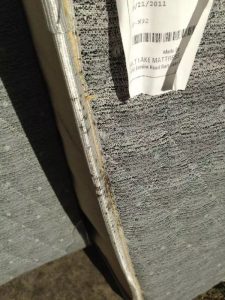
Pictured below is a bed bug walking across the bottom of a box spring.
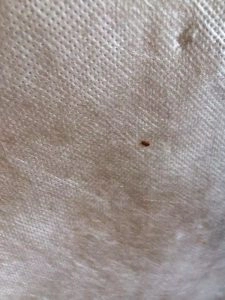
Step 4: Check the Bed Frame and Headboard
Bed frames, particularly wooden frames, and upholstered headboards, provide additional hiding places for bed bugs. Focus on:
- Joints and screw holes: Bed bugs can hide in cracks where pieces of the frame connect.
- Under slats or support beams: Platform beds with storage compartments may also be affected.
- Headboards: Upholstered headboards with seams, fabric folds, or button tufts can be major infestation spots.
- Back of the headboard (if attached to the wall): Bed bugs can squeeze into tiny gaps between the headboard and wall.
Step 5: Inspect Nearby Furniture and Surrounding Areas
Bed bugs typically stay close to their host, with 95% of infestations occurring within 3 feet of the bed and 75% within just 1 foot. However, if left untreated, they can travel over 100 feet in a night to find a new host. Therefore, it’s crucial to check:
Curtains and carpet edges: Check the folds of drapes and where the carpet meets the wall.
- Nightstands and dressers: Remove drawers and inspect the interior corners, joints, and undersides.
- Upholstered furniture: Examine seams, tufts, skirts, and zippers of sofas and chairs near the bed.
- Walls and baseboards: Look behind picture frames, under lamps, along baseboards, and inside electrical outlets. Do not open outlets without professional guidance.
What to Do If You Find Bed Bugs
If you’ve completed all five steps and found evidence of bed bugs, do not attempt to remove them yourself. DIY treatments often worsen the problem by spreading the infestation to other areas of the home.
Instead, call A-1 Exterminators at (801) 968-3370. Our proven bed bug extermination process includes:
- A detailed inspection to locate all infestation areas.
- Three targeted treatments over six weeks to ensure complete eradication.
- A 45-day guarantee—if bed bugs persist after treatment, we’ll return at no extra cost.
Our team has over five and a half decades of experience handling bed bug infestations throughout Salt Lake City and Northern Utah. We provide safe, effective treatment with long-lasting results.
Preventing Future Bed Bug Infestations
After eliminating bed bugs, take these proactive steps to prevent re-infestation:
- Use mattress and box spring encasements to keep bed bugs from hiding.
- Vacuum regularly around sleeping areas and dispose of vacuum bags immediately.
- Be cautious when traveling—inspect hotel beds and luggage before bringing them home.
- Avoid bringing used furniture indoors unless you thoroughly inspect it.
If you have any concerns about bed bugs in your home, contact A-1 Exterminators for expert advice and professional extermination services.
Final Thoughts
Bed bugs are persistent pests, but early detection and professional treatment can make all the difference. These five steps can help you identify an infestation before it spreads, protecting your home and peace of mind. If you suspect bed bugs, don’t wait—professional intervention is the most effective way to eliminate them for good.
Call (801) 968-3370 or contact us online to schedule an inspection today!


